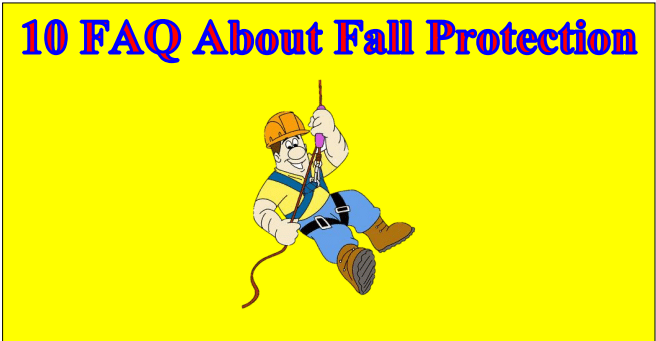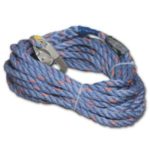10 FAQ about Fall Protection
Table of Contents
ToggleThis article we have laid out 10 FAQ about Fall Protection and the answers you need to know. This has been put together in the hopes of better informing workers. Illustrating Fall Protection FAQ, helps keep every worker safer on the job site.
1. Do I need to be trained to use a Fall Protection Harness?
YES! Absolutely you need training to Donn and fall protection harness and tie off to a structured anchor point. If you have never used fall protection PPE, it is not only highly recommended, its the law. In the WorkSafe BC Regulations states:
11.2(6) Before a worker is allowed into an area where a risk of falling exists, the employer must ensure that the worker is instructed in the fall protection system for the area and the procedures to be followed.
Training can be found right here
2. Is it Safe to Buy a Used Fall Protection Harness?
NO! Never under any circumstances buy used fall protection PPE from any type of market place, especially online sources. The reason being, you do not know what the history is for any used Harness, lanyards, or anchoring equipment. Ask yourself one question. Do I abso0lutly trust the person who is selling the fall protection PPE? Unless you are Qualified or deemed a Competent person, you might not be able to identify specific damage that could pose a danger to you wearing the harness and if you sustained a fall.
3. When Must Fall Protection Be Used?
Explicitly defined in Part 11 of the the WorkSafe BC Regulations, Fall Protection must be used when working at a height of 10 feet, within 6.5 feet of a leading edge. Yet this only applies if the lower surface is flat without debris or obstructions. What if you're working at 7 feet high, and below has a pile of rubbish or perfectly stacked material? The decision to use fall protection is not only a smart one it's in the regulations. It must be remembered, the regulations around working at heights are the minimum legal requirements.
4. Can I still be injured in a Fall even if I’m wearing a harness?
Yes. You can still be injured in a fall even though you're wearing a harness. In fact, a harness in one specific type of PPE that could be the cause of a fatality.
Injuries
If a fall is to happen, you could crack or brake your ribs, sustain bruises over your body, extremely sore muscles and potentially whiplash or a concussion do to a swing hazzard.
Fatalities
Furthermore, fatalities can be the result if a worker falls and if not rescued in a short amount of time. A serious injury called Suspension Trauma (also known as Orthostatic Intolerance, or Harness Hang Syndrome) can be the result. More on this can be found here. In addition, if a worker were to be knocked unconscious and their head is slumped forward, they might not be able to breath, thereby suffocating. Time is crucial in a rescue.
5. How do I choose what Fall Protection to use?
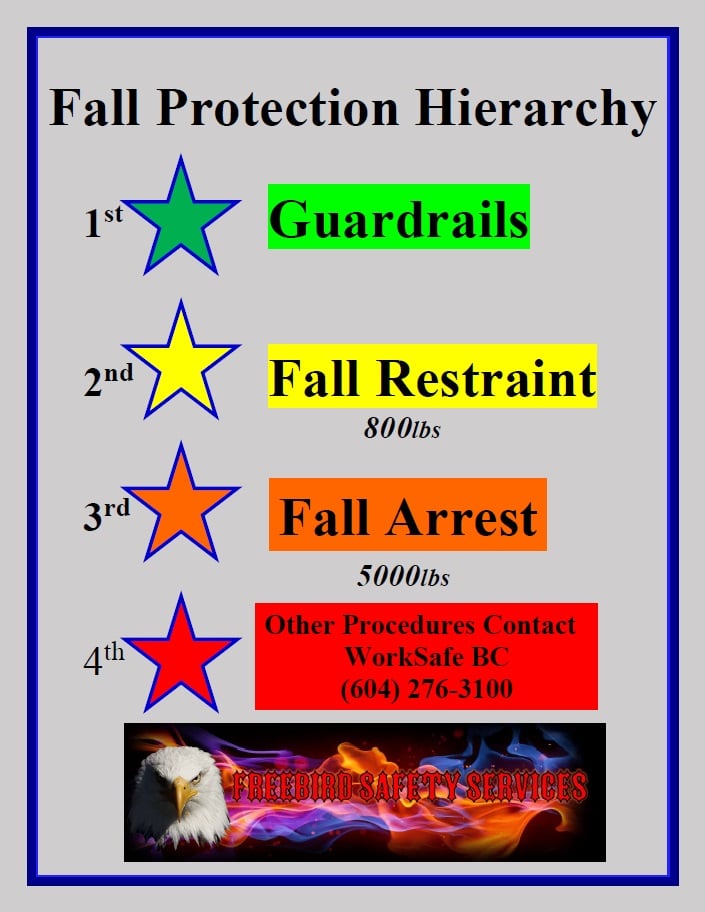
Fall Protection Hierarchy
When deciding on what type of fall protection to use when working at heights, always follow the Fall Protection Hierarchy. Your first choice should always be to use Guardrails, followed by Fall or Travel Restraint, then Fall Arrest.
A forth choice might ba a control zone. But only on a flat surface (upto and including a 3-12 pitch),
Guardrails
In the event that you have to perform a work task at heights, the first choice for Fall Protection should always be the use of Guardrails. These are considered a passive fall protection system. Having a physical barrier between you and a fall gives you complete freedom of movement. In addition, you don't have to wear a harness and be tied off.
However, not all guardrails are constructed equally. As a matter of fact, some guardrails that are temporary might be very unsafe. A few pieces of lumber held together with some nails. Inspect and make note of their construction and how they are attached.
Specification
-
-
- All guardrails must withstand a minimum force of a load applied horizontally and normal to the span of the rail, of 125 lbs
- They must be installed at all locations where a fall of 10 feet or more exist
- In addition, all raised floor, open-sided floor, mezzanine, gallery, balcony, work platform, ramp, walkway, runways, open containers, vats, bins, tanks that have a drop of 4 ft or more above the adjacent surface level must have a guardrail as well.
- Temporary guardrails, if constructed on-site, must follow specific guidelines. 2x4 rails can only span 8 feet from post to post. If the span is greater and up to 10 feet, then 1x6 rails must be used.
-
Fall Restraint
When a guardrail system can not be utilized, the next choice should always be a Fall Restraint System. Part of the Active fall protection system, the 3 main parts of this system are, a harness, connection devices, and anchors. In the event a temporary anchor is used, it has to support a minimum of 800 lbs.
All other components from permanent anchors, connection devices like lifelines and lanyards to the harness itself must be rated for 5000 lbs. There are no shock absorbers or shock packs used in a restraint system. When used correctly a worker can only go as far as the leading edge and no more. Retractable lanyards are perfect for this application.
Fall Arrest
Fall Arrest is an active system and must be used at 10 feet. However, 2 very significant differences between arrest and restraint. Fall Arrest anchors must be rated for 5000 lbs. The second is the lanyard. Equipped with shock absorbers or shock pack, the weight rating of the temporary anchors must increase.
All components must be rated for 5000 lbs. Unlike a restraint system, with an arrest system, a person can still fall off the edge. The shock absorber will deploy slowing (arresting) the fall. As a result, when they hit the end of slack, the anchor has to support the forces exerted on it. Furthermore, using an arrest system increases the chances of a rescue being required.
6. What is a Generic Personal Fall Protection Systems?
There are 3 main components to a Generic Personal Fall Protection System.
-
- Your Harness
- All Connecting Devices
- The Anchors
However, each component has multiple different models, styles, manufactures, weight classes, and so on.
Above all, every component must be approved and have either a CSA number or an ANSI number printed on a label or stamped on the metal parts. If you can't read the number, don't use the device. Even though it looks in good shape, a daily inspection must be performed and logged.
7. What are the different classifications or Harnesses
Harnesses come in 5 classifications and are used is various different aspects of work ,occupations and specific tasks. Below is a general description of these 5
1. Class A Fall Restraint or Fall Arrest
Class A harnesses are designed to protect workers when they are ten feet or more above the ground. They support the body during and after a fall. Dorsal (back) D-rings are used for fall protection. They slide on impact, keeping the worker in an upright position. These are most commonly used in Construction
2. Class D Suspension and Controlled Descent
Class D harnesses are used to support and hold a worker while being raised and lowered. There is one sternal (front) D-ring and one dorsal (back) D-ring. The sternal D-ring is used for attachment to a descent device.
3 Class E Limited Access
Class E harnesses are designed to raise or lower a worker through a confined area. Shoulder D-rings serve as anchorage points for attaching an extraction yoke or other rescue device. The D-rings slide on the shoulder strap for optimal positioning of the worker.
4. Class L Ladder Climbing
Class L harnesses are designed for use with a certified fall arrester that travels on a vertical lifeline or a rail. Sternal (front) D-rings are used for attachment to the vertical system. Used on long ladders, towers, or other permanently mounted vertical climbs.
5. Class P Work Positioning
Class P harnesses will hold and sustain a worker at a specific location, allowing full use of the hands, while limiting any free fall to two feet or less. Side D-rings at waist level is used for positioning and restraint. Safety belts are in this class.
8. What are some types of Fall Protection Connecting Devices
Connecting Devices are the components that connect the harness to an anchor point. There are a several different types of connecting devices, and with in each type different styles and configurations Some are needed to be used exclusively with other devices, such as rope life lines and rope grabs. Others ar4e used to connect different components together. Here are just a few:
-
- Snap Hooks
- Fall Restraint Lanyards
- Fall Arrest Lanyards
- Retractable Lanyards
- Carabiners
- Rope Lifelines with Rope Grabs
- Cable Lifelines with Cable Grabs
Snap Hooks
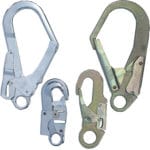
Lanyards
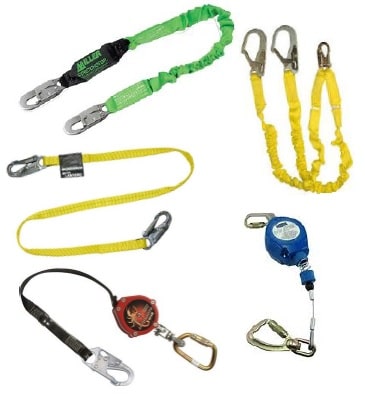
-
-
- Webbed type lanyards;
- Synthetic rope and
- Wire rope.
-
They also come in 3 different types
- Fall Restraint lanyards;
- Fall Arrest lanyards
- Retractable lanyards.
Although not all can be shown here, these give an idea of the most common lanyards used
Carabiners
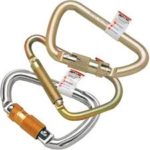
Rope Lifelines and Rope Grabs
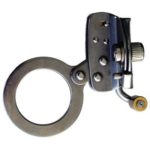
9. What are some kinds of Fall Protection Anchors
Ordinarily, only one worker is allowed to tie off to a single anchor point at any time. Given this point, if an anchor has been designed to support more than one worker, it must be certified by a professional engine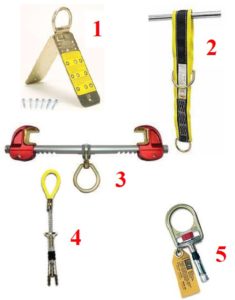
Whenever a worker is using a temporary anchor, this device must be removed on completion of the work. At the same time, if a temporary anchor is used in a fall restraint system, it must have a minimum load capacity of no less than 800 lbs. in any direction the load may be applied. Fall Arrest is 5000 lbs.
Types of Anchors
1. Winged Roof Anchors
Straddling over a ridge, screws are used to hold the plate in place on the sheathing of a roof. Steel plates rated at a minimum of 5000 lbs tensile strength. The weak link in this system is the pull strength of the screws and wood sheeting. Always read the manufacturer's instructions
2. Straps
These are one of the least expensive ways to anchor yourself. Light and easy to use, but they do have limitations. If any stress is placed upon them, they must be decommissioned. Do not use it on a rough surface with the potential to cut. Do not nail through them or use a marker on them. Rated at 5000 lbs.
3. I-beam Anchors
These Achor devices are widely used by the Iron Workers and Erectors. By sliding the jaws around the top plate of an I-beam a worker can move across the beam without any limitations. In most cases workers are using a set of 2, there by being able to always be tied or anc hored off even while jumping over cross sections of I beam.
4. Condor
Condors are temporary concrete anchors that are quick and easy to use. A hole is drilled into cured concrete, the anchor is inserted, and the force of its pull upwards wedges the device solid in place. With a rated strength of 5000 lbs. always read the manufacturer's instructions before installing. Given these points, follow silica dust and PPE procedures when drilling into concrete.
5. Permanent Anchors
Permanently staying in place when installed, these must be certified by an engineer, and be rated for at least 5000 lbs. In the same fashion as all other devices, these must be inspected before every use.
10. What to do with our Fall Protection PPE when finished using it.
At the end of the work day, always inspect your gear for any damage that might have occured. If damage is detected, remove it from service, tag it as damaged, and report it to your supervisor. On wet and dirty days, wash of any debris with nothing stronger then a mild dish soap. Always dry your harness and other devic es with a dry towel and then hang it up over night in a warm environment. Never leave your harness and other devices in the mud, on the floor, or in any position where damage can occur. If you don't take care of you Fall Protection PPE, it will not take care of you.

